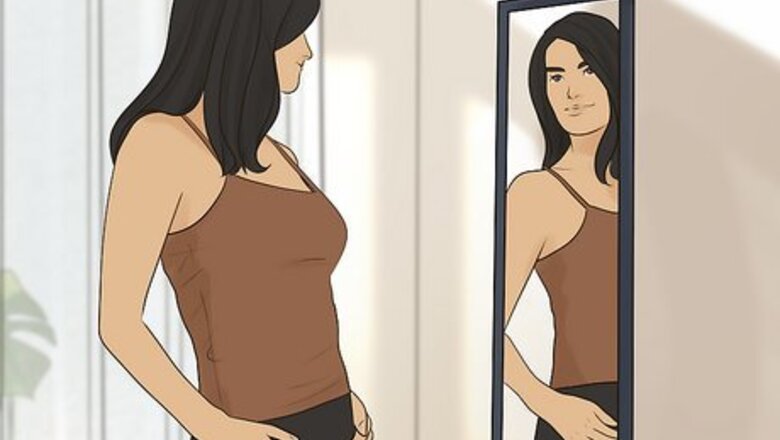
views
The 13 Kibbe Body Types
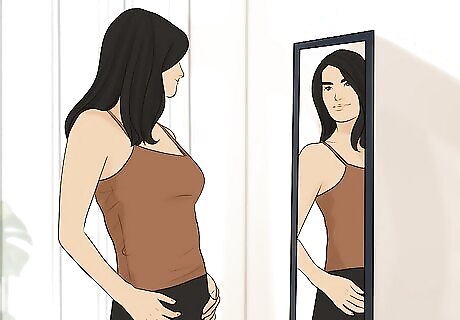
Dramatic Dramatics have fully yang features defined by angularity, sharpness, sleekness, and height. Celebrity examples of dramatics include Tilda Swinton, Keira Knightley, and Lucy Liu. Styling Tips: Look for long vertical lines that are tailored for sharpness, like long and straight trousers or coats. Wear a simple silhouette with little detail and a monochromatic color scheme. Opt for sharp, geometric shapes and heavy fabrics. Height: Usually average to tall with a long vertical line. Body Type: Straight and angular, possibly sleekly muscular with long and narrow limbs. Bone Structure: Angular with sharp edges. Square, narrow shoulders. Long and narrow hands and feet. Sharp and prominent facial bones. Facial Features: Straight, sleek lines. Small, almond-shaped eyes. Thin, straight, or narrow lips. Taut skin around the cheek and jaw. A Dramatic will Not: Have an hourglass figure. Have full cheeks and lips or round eyes. Have broad or blunt facial bones (e.g., cheekbones). Be petite or appear extremely short or dainty. Be perfectly symmetrical. Have short or fleshy limbs.
Soft dramatic The soft dramatic body type is mostly yang with some strong yin features, creating a balance of angularity and softness. Celebrity examples of soft dramatics include Tyra Banks, Ava Gardner, and Sophia Loren. Styling Tips: Choose clean and long lines that have some soft draping and waist definition. Use minimal color blocking and pattern detail, but wear large watercolor prints for softness. Aim for volume around your shoulders with elongation throughout the rest of your body. Height: Usually moderate to tall with a long vertical line. Body Type: Fleshy throughout the hip and bust with a moderate-sized waist and long arms and legs. They may carry weight in their upper arms or legs. Bone Structure: Large and angular. Long limbs, large hands, and feet, prominent and sharp facial bones, and bone structure. Facial Features: Large eyes, full lips, and fleshy cheeks. May be described as sensual or lush. A Soft Dramatic will Not: Have a boyish figure. Have small hands or feet or delicate bone structure. Be overly petite or have short limbs. Be symmetrical in body type or facial features.
Flamboyant natural This tall, lean, and blunt body type is yang-dominant with a natural softness. Flamboyant naturals are generally softer than dramatics but aren’t soft enough to be fully natural. Celebrity examples of flamboyant naturals include Princess Diana, Michelle Obama, and Cameron Diaz. Styling Tips: Use relaxed and unstructured silhouettes with sweeping lines and no waist emphasis. Wear loose, oversized garments with asymmetrical elements, unusual color combinations, and textured fabrics. Height: Usually moderate to very tall with a long vertical line. Body Type: Straight, broad, angular. Limbs tend to be muscular with flat or straight busts and hips. Bone Structure: Large and angular with blunt edges. Broad and square bones with wide shoulders, long limbs, and large hands and feet. Facial bones are typically broad, prominent, and blunt—but never sharp. Facial Features: Eyes may be large and open or straight and small. Straight and slightly thin lips, typically with taut cheeks. A Flamboyant Natural will Not: Have a curvy bust or hipline. Have an hourglass feature. Have small or delicate facial features. Be petite. Have any sharpness in their bone structure or narrow features.
Natural The natural is similar to a dramatic but with blunt edges rather than the sharpness of a full yang body type. Naturals generally have a straight and slightly muscular bone structure. Celebrity examples of naturals include Ali MacGraw and Jennifer Aniston. Styling Tips: Keep your clothing lines relaxed and straight with soft tailoring but an unstructured shape. Maintain a narrow and slim shape in your clothing while still having it fit loosely and comfortably. Long scarves and cardigans accentuate your long vertical line, while fun color combinations help break up your frame. Height: Usually moderate to slightly tall with a long vertical line. Body Type: Straight, lean, and muscular with no waistline definition. Flat hips and mostly flat bust line with slightly long limbs. Bone Structure: Slightly straight and angular with blunt edges. Squarish structure through the body and face with broad shoulders, large and squarish hands, and blunt facial bones. Facial Features: Slightly broad, blunt or irregular. Medium- to small-sized eyes. Taut cheeks with slightly wide and open features. Straight and slightly thin lips. A Natural will Not: Have an hourglass feature. Be either extremely short or extremely tall. Have very prominent or unique features. Have evenly spaced features. Have extremely sharp features. Have a boyishly thin feature without any musculature in the limbs.
Soft natural A soft natural blends together yin with a softened yang. The resulting body type is straight and angular but with more roundness than a pure natural. Celebrity examples of soft naturals include Jada Pinkett Smith and Molly Ringwald. Styling Tips: Embrace your natural lines with unconstructed silhouettes that have shaping at the waist. Opt for soft fabrics and natural materials that will drape nicely over your figure. Wear soft, neutral, or pastel color combinations to keep your outfits looking relaxed and natural. Height: Usually moderate to slightly short. Body Type: Slightly soft, fleshy, and curvy. Could have a subtle hourglass shape with a slightly small waist and fleshy upper arms and thighs. Bone Structure: Slightly angular bones and broad shoulders. Moderate to slightly short limbs with wide and fleshy hands and feet. Facial bones are slightly blunt or small and irregular. Facial Features: Full lips, soft cheeks, and rounded eyes. Nose may be small and wide or slightly blunt and wide. A Soft Natural will Not: Have an extremely straight body type. Have extremely sharp features or bone structure. Appear very tall. Have a very large and broad bone structure.
Dramatic classic The dramatic classic is almost perfectly balanced between yin and yang but leans a little bit more toward the yang side. This body type is balanced and symmetrical with slightly angular and muscular features. Celebrity examples of dramatic classics include Phylicia Rashad, Diane Kruger, and Olivia Wilde. Styling Tips: Complement your angularity with sleek and straight lines that have structured, sharp edges. Look for geometric details like pleats and crisp cuffs. Create contrast in your outfits by pairing neutrals and deep colors together. Height: Usually moderate with a moderate vertical line. Body Type: Naturally trim and compact with a slight musculature. Bust, waist, and hips are all in even proportion and a somewhat straight line. Limbs are average or slightly long. Bone Structure: Symmetrical with slightly angular edges. Shoulders are narrow, tapered, or slightly square. Hands and feet are slightly squarish, as are the contours of the face. Facial Features: Moderate to large eyes and moderately-sized lips. A Dramatic Classic will Not: Have extremely long limbs. Have overly full or rounded facial features. Have extremely large or delicate bones and limbs. Have an hourglass figure or a boyishly straight figure.
Classic The classic body type is a perfect balance between yin and yang. The resulting look is balanced, refined, and understated, with completely even and symmetrical proportions. Celebrity examples of classics include Grace Kelly, Isabelle Huppert, and Cybill Shepherd. Styling Tips: Stick with smooth and symmetrical outfits that have straight or smoothly curved lines. Opt for a clean, unbroken silhouette that slightly emphasizes the waist but maintains your symmetrical figure. Look for classic cuts with low-contrast color combinations and lightweight textures like cashmere and silk. Height: Usually moderate with a moderate vertical line. Body Type: Evenly proportioned throughout the bust, waist, and hips. Slightly lithe and sinewy with some musculature and moderate limb length. Bone Structure: Symmetrical and straight with a slight sharpness and angularity. Tapered shoulders and moderately-sized hands and feet. Facial Features: Highly symmetrical, chiseled, and evenly spaced. A Classic will Not: Appear extremely tall or petite. Have extremely prominent or delicate features. Have an hourglass figure. Have large hands or feet. Have full or extremely rounded facial features.
Soft classic The soft classic is balanced like the pure classic but with rounder yin features. Soft classics are just as refined and symmetrical as their pure counterparts, but they have slightly more fullness and softness to their features. Celebrity examples of soft classics include Meryl Streep and Marion Cotillard. Styling Tips: Look for clean, symmetrical lines that slightly shape your waist. Add soft accessories with rounded shapes like scooped necklines, soft pleats, or rounded folds. Choose light prints and colors on fabrics that drape and flow easily along your figure. Height: Usually moderate with a moderate vertical line. Body Type: Slightly rounded with some fleshiness. Soft arms, thighs, and waistline with a proportionate bust, waist, and hips. Arms and legs are moderately short in proportion to the overall height. Bone Structure: Symmetrical with slightly rounded edges. Features are straight and slightly wide, but always with soft edges. Shoulders are slightly sloped with slightly small and wide facial bones. Facial Features: Soft, full, and slightly fleshy. Features are symmetrical and evenly spaced, with large eyes, soft cheeks, and full lips. A Soft Classic will Not: Have a large or angular bone structure. Have extremely prominent or delicate facial or body features. Be extremely petite or appear very tall. Have a true hourglass figure with a clearly defined waist. Have a boyish or muscular body type.
Flamboyant gamine A flamboyant gamine balances the yin and yang shapes with a bit of drama. This body type is usually balanced overall in a petite frame, but usually has something about them that’s exaggerated. For example, they may be particularly leggy or have large, round eyes. Celebrity examples of flamboyant gamines include Audrey Hepburn and Penelope Cruz. Styling Tips: Aim for a sharp, geometric silhouette to complement your yang lines. Opt for asymmetric and irregular shapes that are boxy or sculpted with soft or sharp edges. Break up the silhouette by using different colors on your top or bottom—and keep your colors vibrant and bold! Height: Usually short with a short vertical line. Body Type: Lean and strong with a very defined musculature. Straight lines along the body with a flat bust, straight hips, and a leggy look. The tendency toward squareness rather than curves. Bone Structure: Broadly angular with slightly wide bones. Square shoulders, large hands and feet, slightly sharp or broad facial contours, and long arms and legs. Facial Features: Extremely large eyes with a broad or long facial shape. Facial flesh is typically taut with moderate to full lips. A Flamboyant Gamine will Not: Appear tall. Have a delicate bone structure with disproportionately small hands and feet. Have an hourglass figure with a defined waist and curvy hips/bust. Be symmetrical.
Gamine Gamines blend together a yin face with a yang body. While balanced overall, a gamine’s petite and narrow frame contrasts with full and rounded facial features. Their lines tend to be sharp and straight throughout their bone structure. Celebrity examples of gamines include Mia Farrow and Emma Watson. Styling Tips: Aim to create a sharp and fitted silhouette that emphasizes your waist. Dress in a gamine style with bold details that are small, sharp, and attention-grabbing. Fabrics should be crisp and defined with a matte finish and bold colors. Height: Usually short with a short vertical line. Body Type: Straight, lithe, and lean with sinewy musculature. Flat in the bust and hips, possibly short-waisted, and likely very leggy. Bone Structure: Angular, sharp, narrow, and sometimes delicate. Narrow shoulders that can be square or tapered in shape. Delicately sharp facial contours. Long arms and legs with small and narrow hands and feet. Facial Features: Large eyes and taut cheeks with straight and narrow lips. A Gamine will Not: Be over 5’5” (168cm) tall. Have an extremely large bone structure or prominent features (besides large eyes). Have large hands or feet. Have an hourglass figure with a small waist and full bust/hips. Be symmetrical.
Soft gamine Soft gamines package the body of a yang into a yin body. Their bone structure is slightly broad and angular, especially in the shoulders and jawline. However, the soft gamine still has small and delicate features that are usually rounded or soft. Celebrity examples of soft gamines include Bette Davis and Jenna Coleman. Styling Tips: Look for clothing that combines clear and rounded lines with sharp corners and edges. Aim for a fitted and feminine silhouette that’s sharply tapered to emphasize the waist, collar, and cuff. Choose lightweight and crisp fabrics in vivid and intense shades to highlight your playfulness. Height: Usually very petite with a short vertical line. Body Type: Soft, curvy, and fleshy body with a curved bustline and lips. Natural waist definition with soft and fleshy arms. Bone Structure: Simultaneously delicate and small as well as slightly broad and angular. Angular edges in the shoulders with small hands and feet. Facial contours are delicately broad with slight angularity. Arms and lengths are slightly short in relation to height. Facial Features: Doll-like facial features like round eyes, full cheeks, and plump lips. Typically has a very round facial shape, perhaps with a slightly sharp or squared jawline. A Soft Gamine will Not: Appear tall. Be extremely thin or have an extremely straight body type. Have a large or wide bone structure. Have large hands and feet. Have a sharp bone structure.
Theatrical romantic The theatrical romantic is almost entirely yin but with a touch of yang. Their body type is mostly soft and delicate, yet they have broad and sharp facial features that set them apart from the pure romantic. Celebrity examples of theatrical romantics include Rihanna and Hedy Lamar. Styling Tips: Wear fitted silhouettes that emphasize your hourglass figure and sharply define your waist. Add angularity through tapering at the wrists, hemline, and knee while keeping the rest of your silhouette soft, flowing, and clingy. Look for drapey, lightweight fabrics in light and bright colors. Height: Usually moderate to petite. Body Type: Soft and voluptuous but naturally trim and petite. Hourglass figure with a curvy bust, rounded hips, and defined waist. Arms and legs are soft and fleshy. Bone Structure: Small and delicate with slightly sharp edges. Hands and feet are small in relation to height. Facial Features: Soft and lush with large eyes, full lips, and soft cheeks. A Theatrical Romantic will Not: Appear extremely tall. Have large or wide bones, hands, or feet. Have extremely prominent or sharp facial bones. Have small eyes or thin lips. Have a straight figure with an undefined waist.
Romantic Pure romantics are all yin and are often described as voluptuous with soft, rounded, and curvy features. While their bone structure is short and wide, romantics don’t necessarily look heavy because their overall proportions are small and delicate. Celebrity examples of pure romantics include Marilyn Monroe and Beyoncé. Styling Tips: Match your body’s roundness with soft, circular, and intricately flowing shapes in your clothing. Look for details like ruffles, bows, and round necklines. Keep your silhouettes well-fitted and flowing to show off the curves of your body, and make sure to accentuate the waist. Pale, delicate colors paired with lightweight or softly woven fabrics will work the best. Height: Usually moderate to petite with a short vertical line. Body Type: Soft and voluptuous with a curvy hourglass figure. Full bust and hips with a small waist in proportion to the curves. Fleshy arms and legs. Bone Structure: Features are delicate and small but sometimes slightly wide. Shoulders are rounded with small hands and feet that may sometimes be wide. The bone structure is very delicate but may appear larger due to its width or lushness. Facial Features: Rounded, full, and sensual with large eyes, full lips, and fleshy cheeks. A Romantic will Not: Appear extremely tall. Have a large bone structure or large hands and feet. Have a straight figure or any sharpness in their features. Have a prominent nose or angular chin.
What is the Kibbe system?

The Kibbe system includes five body type families with 13 total types. The five overarching categories are dramatics, classics, naturals, gamines, and romantics. Within each family, there are sub-body types that represent a blend of different possible features and contrasts. The 13 Kibbe body types are dramatic, soft dramatic, flamboyant natural, natural, soft natural, dramatic classic, classic, soft classic, flamboyant gamine, gamine, soft gamine, theatrical romantic, and romantic.
Each Kibbe body type exists on a spectrum of “yin” and “yang.” “Yang” refers to features that are more sharp, angular, blunt, or long, while “yin” features are more soft, rounded, curved, or short. Rather than being based on bust or hip measurements, the Kibbe system uses the yin/yang balance to find harmony in the body’s natural lines. Dramatics are the purest yang body type, while Romantics are the softest, most yin body type. The in-between types on the spectrum feature some specific blend or contrast of yin and yang features, as defined by the Kibbe system.
History & Criticism of the Kibbe Body System
The original Kibbe body system was invented by stylist David Kibbe. The concept was introduced in his 1987 book David Kibbe’s Metamorphosis: Discover Your Image Identity and Dazzle as Only You Can. Originally referred to as an “image identity” system, Kibbe developed a styling handbook for 13 body types based on the interplay of geometric shapes, lines, and curves. The intent was for women to be able to style themselves according to their body shape and type. However, Kibbe meant for his styling process to be used much more fluidly than how body typing is used today. Rather than strictly advising women on what they should or should not wear, Kibbe wanted to give a set of loose guidelines as to what types of clothing would flow harmoniously with their natural shape. In its modern iteration, the biggest benefit of the Kibbe system is giving people basic guidelines for styling that go beyond traditional body typing based on weight or simplified body proportions.
The Kibbe body system has gained popularity on social media platforms. Numerous TikTok accounts, YouTube channels, and styling blogs are now dedicated to Kibbe body typing. Some content creators even provide services to determine your Kibbe body type, often using examples of different celebrities to illustrate their points.
Critics of Kibbe typing point to Eurocentric beauty standards and body image issues. The original Kibbe system only used Old Hollywood celebrities and body ideals as examples. These Eurocentric ideals of beauty largely applied to White individuals with European ancestry and failed to account for body diversity across race, gender, and genetics. Examples of Kibbe body types hardly ever feature BIPOC women, transgender women, or women in bigger bodies, and categorizing people based on body type or appearance can be a slippery slope toward body image issues, eating disorders, and fatphobia. Many modern consumers are also tired of the focus on “flattering” or “slimming” silhouettes and want to move toward a fashion community where personal style is more important than dressing one’s body type to conform to the so-called ideal figure. Other traditional body typing systems have faced similar criticisms and have largely fallen out of favor—the most infamous of which categorized female body types into vague shapes like apples, pears, upside-down triangles, hourglasses, and pencils. Another body-typing system categorized people into three "somatypes" (ectomorph, mesomorph, and endomorph) and connected these physiques to certain personality traits—a system whose scientific accuracy has been thoroughly debunked by modern research.
The Kibbe Body Type Test
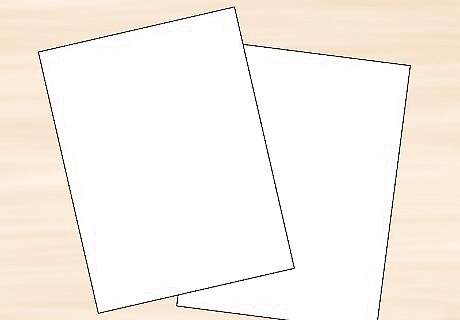
Take out a piece of paper and pen to record your responses. Divide your paper into three sections: I) Bone structure, II) Body Flesh, and III) Facial Features. Each section will have between 4-7 multiple choice questions with answer options A-E. Record your answers in their respective sections. The answers range between yin and yang body features. A & B answers are more yang dominant, while D & E answers are more yin dominant, according to the Kibbe system. The C answer for each question is a blend of yin and yang. If you don’t strongly identify with either A/B or D/E, select C as your response to that question. At the end of the assessment, you’ll tally which letter response you have the most of to find your Kibbe body type. Alternatively, you can take this Kibbe Body Type Test. However, doing your own self-assessment may give you a more accurate answer.
Take a picture of yourself in a swimsuit or underwear. Stand up straight and position the camera at chest level to take a full-body shot. The shot must be taken straight-on so that your body parts represent their real-life proportions as accurately as possible. Take a headshot with the camera held directly in front of your face. Make sure you’re not wearing any makeup, and take a straight-on, centered shot of your entire face. Examining these photos while completing the assessment will help you objectively observe the proportions of your body and face.
Answer the questions below for Part 1: Bone Structure. This section accounts for your body’s underlying bone structure—which has nothing to do with the amount of flesh on your bones. Your bone structure is not subject to weight fluctuation. The bone structure section is considered the most important one in determining your Kibbe body type, so answer the questions carefully. 1) How long is your vertical line? A) Long—I have a small head in relation to my body, and I appear a lot taller than I actually am (even if I’m below average height). E.g., Tilda Winton, Tyra Banks, Sophie Turner. B) Moderately long—I have a moderately small head in relation to my body, and I appear somewhat taller than I actually am (even if I’m below average height). E.g., Cameron Diaz, Liv Tyler, Angeline Jolie. C) Moderate—my head is proportionate to my body, and I look exactly like my actual height. E.g., Diane Kruger, Olivia Munn, and January Jones. D) Smallish—my head is moderately large in relation to my body, and I appear shorter than I actually am (even if I’m above average height). E.g., Carey Mulligan, Kendall Jenner, and Keira Knightley. E) Petite—my head is large in relation to my body, and I am very obviously short and small in stature. E.g., Hayden Panettiere, Christina Ricci, Emilia Clarke. 2) What shape are your shoulders? A) Narrow & sharp—my shoulders are angular and bony without any softness or roundness. They are narrow and abruptly transition from shoulder to arm. E.g., Gigi Hadid. B) Broad & blunt—my shoulders are broader and wider than A, with blunt edges that transition to the arms. They may be described as slightly masculine. E.g., Eva Mendes. C) Symmetrical & even—my shoulders are neither angular nor sloped, and I can’t identify with any of the other shoulder descriptions. E.g., Amy Adams. D) Sloped & tapered—my shoulders have a notable slope and appear dainty but with sharp edges. E.g., Emma Watson. E) Sloped & rounded—my shoulders have a noticeable slope and are very narrow. They are rounded at the edges without any sharp angles. E.g., Rihanna. 3) What is the length and shape of your arms and legs in relation to the rest of your body? A) Elongated & narrow—my arms and legs are very long. My fingertips reach more than halfway down my thighs when relaxed, and the bones of my elbows, wrists, and ankles are very thin. E.g., Thandie Newton. B) Elongated & broad—my arms and legs are long. My fingertips reach more than halfway down my thighs when relaxed, and the bones of my elbows, wrists, and ankles are wide and broad. E.g., Jennifer Aniston. C) Moderate, even in proportion to my height and torso—my arms and legs are proportionate to the rest of my body. My fingertips end about halfway down my thighs when relaxed. E.g., Olivia Wilde. D) Small & slightly short—my arms and legs are slightly short compared to the rest of my body. My fingertips don’t reach halfway down my thighs when relaxed. E.g., Rita Ora. E) Small & very short in proportion to height and torso—my arms and legs are very short compared to the rest of my body. My fingertips don’t reach halfway down my thighs when relaxed. E.g., Ariana Grande. 4) What is the size and shape of your hands and feet? A) Long & narrow—my hands are large in comparison to my face. They have a long and narrow shape with long palms and fingers. E.g., Eva Mendes, Tyra Banks, and Uma Thurman. B) Large & broad—my hands are large in comparison to my face. They have a long and wide shape with broader palms and fingers. E.g., Angelina Jolie, Julia Roberts, and Candice Swanepoel. C) Moderate, neither very large nor very small—my hands are proportionate to my face in body. They are neither very large nor very small and neither very narrow nor very broad. E.g., Priyanka Chopra, Jessica Chastain, and Marion Cotillard. D) Small, narrow & delicate—my hands are small in comparison to my face. They are narrow, long, and delicately shaped. E.g., Mila Kunis, Shakira, and Demi Lovato. E) Small & slightly wide—my hands are small in comparison to my face but have a wide shape. E.g., Emilia Clarke, Emma Watson, and Hayden Panettiere.
Answer the questions below for Part 2: Body Flesh. This section focuses on the overall look of your flesh, skin, and muscles. Keep in mind that this section has nothing to do with the amount of body fat you have. For example, some people naturally have soft and full cheeks, while others have taut skin on their cheekbones, regardless of weight or muscle mass. 1) What is the overall shape of your body? A) Long, lean, dry—my body type is long and straight without any defined curves. My breasts are small- to average-sized with a straight, undefined waist and narrow hips. When my weight fluctuates, I still don’t develop any defined curves. E.g., Keira Knightley. B) Broad, slightly muscular—my body type is broad with wide shoulders and a wide, undefined waist. My hips are narrower than or the same width as my shoulders. When my weight fluctuates, I become stocky rather than curvy. E.g., Doutzen Kroes. C) Moderate, even—my body shape is moderately defined at the waist, and my bust and shoulders are equal in width. My waistline isn’t defined enough to be considered an hourglass, but it’s not completely straight. E.g., Hailey Bieber. D) Shapely, delicate hourglass—I have an hourglass figure, but my shoulders are more sharp than rounded. When my weight fluctuates, my body becomes curvier, but the sharpness of my shoulders remains. E.g., Halle Berry. E) Very soft, lushly curved, full hourglass—I have a full hourglass figure with rounded shoulders, breasts, and hips. The roundness of my limbs is always noticeable, regardless of my weight. E.g., Sofia Vergara. 2) What shape is your bust line or upper torso? A) Flat, taut—my bust is flat with very small breasts and remains that way despite fluctuations in weight. E.g., Emma Stone. B) Wide, broad—my bust is somewhat flat with small breasts but is broader than answer A. My bust size may change slightly with weight fluctuations. E.g., Lupita Nyong’o. C) Moderate, in even proportion to bust and hips—my bust is moderate in size, and my breasts are neither full nor flat. When my weight fluctuates, my body loses and accumulates flesh evenly, including in my bust. E.g., Padma Lakshmi. D) Shapely, curved, more prominent than my waistline—my bustline is prominent with large and round breasts. My bust size tends to grow when my weight fluctuates. E.g., Olivia Rodrigo. E) Very prominent—my bustline is very prominent with full and rounded breasts and remains so despite fluctuations in weight. E.g., Sydney Sweeney. 3) What shape is your waistline? A) Elongated but boyishly tapered—my waist is long in comparison to the rest of my body. It’s undefined but tapers into my hips and doesn’t change with weight fluctuation. E.g., Olivia Wilde. B) Elongated but broad—my waistline is long compared to the rest of my body, but it’s broader than it is narrow with no definition. E.g., Eva Longoria. C) Moderate, slightly defined—my waist is neither very straight nor very defined, and it’s proportionate to my bust and hips. E.g., Camila Mendes. D) Very small in proportion to bust and hips—my waist is clearly defined with some sharpness to its curve. E.g., Rachel Bilson. E) Softly defined and slightly wide—my waist is clearly but softly defined with a rounded curve and no sharpness. E.g., Jennifer Lopez. 4) What shape are your hips? A) Tapered, straight, narrow—my hips are straight, narrow, and undefined. They tend to change with any fluctuations in weight. E.g., Keira Knightley. B) Straight, slightly tapered, slightly wide—my hips are straight and undefined but wider than answer A. They tend to change with any fluctuations in weight. E.g., Jennifer Aniston. C) Moderate, proportionate to busy and hips—my hips are neither very straight nor very round. D) Shapely and rounded, more prominent than the waist—my hips are prominent and wide and remain so despite any changes in weight. E.g., Lili Reinhart. E) Extremely soft and rounded—my hips are always prominent, soft, fleshy, and rounded, regardless of any weight changes. E.g., Nicki Minaj. 5) Pinch the flesh on your upper arms and thighs. Describe how the flesh on your arms feels, regardless of how much of it you have. A) Long, slender, and sinewy. E.g., Victoria Beckham. B) Elongated and slightly muscular. E.g., Sandra Bullock. C) Moderate. E.g., Jennifer Lawrence. D) Soft and slightly short. E.g., Bella Hadid. E) Very soft, slightly wide, and fleshy. E.g., Chrissy Teigen.
Answer the questions below for Part 3: Facial Features. For this section, make sure you have a straight, clear photo of your face. Remove any makeup and keep a neutral expression without smiling too much. 1) What shape is your jawline? A) Sharp, either pointed or very square—my jawline is very square, angular, and sharp. It’s a prominent feature of my face. E.g., Keira Knightley and Lucy Liu. B) Broad, blunt, slightly wide—my jawline is prominent but has a blunt edge rather than a sharp one. It’s slightly rounded at the edges but still angular. E.g., Chrissy Teigen, Jennifer Aniston. C) Moderate, neither wide, sharp, nor rounded—my jawline has a blend of sharpness and roundness. E.g., Amy Adams, Marion Cotillard. D) Delicate, tapered, slightly rounded—my jawline tapers to my chin and may be very narrow. It shows some sharpness as it slopes downward. E.g., Shakira, Ariana Grande. E) Rounded or softly wide—my jawline is very round without any sharpness. E.g., Kate Winslet and Beyoncé. 2) What shape is your nose? A) Sharp or prominent—my nose is prominent and may be large, but it’s also narrow and sharp. E.g., Cate Blanchett, Tilda Swinton, and Uma Thurman. B) Broad or blunt, slightly large—my nose is broad and may be large, and it’s also quite prominent. E.g., Khloe Kardashian, Jennifer Aniston, and Hillary Swank. C) Moderate—my nose is neither very large nor very small, nor is it very rounded or very sharp. E.g., Jessica Chastain, Taylor Swift, Grace Kelly. D) Delicate, tapered, narrow—my nose is delicate, small, and narrow. E.g., Emma Stone, Lindsey Lohan, and Ariana Grande. E) Rounded or softly wide—my nose is small but is rounded at the tip without any sharpness. E.g., Mila Kunis, Jenna Ortega, Drew Barrymore. 3) What shape are your cheekbones, disregarding the flesh of your cheeks? A) High and prominent—my cheekbones are sharp, narrow, and sit high on my face. E.g., Cate Blanchett, Gisele Bündchen, and Sophia Loren. B) Wide and defined—my cheekbones are somewhat sharp and defined but spread out broadly across my face. E.g., Cameron Diaz, Michelle Pfeiffer, Naomi Campbell. C) Moderate—my cheekbones are neither very prominent nor very sharp nor very rounded. E.g., Cybill Shepherd, Amy Adams, Marion Cotillard. D) Delicate, narrow, and slightly rounded—my cheekbones are very delicate and slightly sharp but not prominent. E.g., Rachel McAdams, Halle Berry, Hedy Lamar. E) Rounded—my cheekbones are extremely soft and rounded. They’re not very prominent, and they’re not at all sharp. E.g., Beyoncé, Drew Barrymore, Madonna. 4) What shape are your eyes? A) Narrow, straight, and closely spaced—my eyes are small, straight, and relatively close together. E.g., Diane Kruger, Claire Danes, and Michelle Dockery. B) Narrow, straight, and widely spaced—my eyes are straight and long and spaced relatively far apart. E.g., Julia Roberts, Rosie Huntington-Wiley, and Cameron Diaz. C) Evenly spaced, moderately wide—my eyes are neither very straight nor rounded, and they’re exactly evenly spaced. E.g., Beyoncé, Blake Lively, and Megan Fox. D) Rounded or upturned, slightly close together—my eyes are larger than the A and B answers but not as large as answer E. They’re slightly rounded or upturned and are relatively close together. E.g., Rihanna, Natalie Portman, Audrey Tautou. E) Very round and very large—my eyes are very large, round, and prominent on my face. E.g., Amanda Seyfried, Anne Hathaway, and Alexandra Daddario. 5) What shape are your lips? A) Straight, narrow—my lips are small, straight, and may be thin. E.g., Karlie Kloss and Kristen Stewart. B) Straight, strong, broad—my lips are straight, but also wide and not very full. E.g., Sandra Bullock and Jennifer Aniston. C) Moderate, even—my lips are not very straight, round, thin, or full. E.g., Jennifer Lawrence and Jennifer Garner. D) Slightly full and rounded—my lips are small but also delicate and rounded. They’re not as full as answer E. E.g., Emma Watson and Reese Witherspoon. E) Very full and very rounded—my lips are large, rounded, and very full. E.g., Kate Winslet and Mila Kunis. 6) What best describes the flesh on your cheekbones, both when smiling and relaxed? A) Flat, taut—the flesh on my cheekbones is taut. When I smile, an indent appears in the hollows of my cheeks. My cheeks never get puffy. E.g., Keira Knightley, Diane Kruger, and Lucy Liu. B) Fairly tight or muscular—the flesh on my cheekbones is fairly tight. When I smile, a slight indent appears in the hollows of my cheeks. My cheeks sometimes get puffy. E.g., Jennifer Aniston, Liv Tyler, and Sandra Bullock. C) Moderate, slightly soft—my cheeks are neither very taut nor very fleshy. E.g., Natalie Portman, Marion Cotillard, and Amy Adams. D) Soft and fleshy—the flesh on my cheekbones is soft and fleshy, but not as rounded as answer E. My cheeks can become very full. E.g., Emma Watson, Mila Kunis, Rihanna. E) Very round and fleshy—the flesh on my cheeks is very round and puffy, even when I’m not smiling. My cheeks are always soft, regardless of my weight fluctuations. E.g., Selena Gomez, Jenna Coleman, and Devon Aoki. 7) What best describes the natural texture of your hair? This question can be skipped if you don’t feel you can answer it accurately. A) Extremely finely textured and silky smooth, either straight or with a slight bend. E.g., Emma Stone. B) Strongly textured, coarse, or heavy hair—either thick and straight or wavy/curly. E.g., Selena Gomez. C) Moderately textured with a slight wave or bend. E.g., Marion Cotillard. D) Moderately thick with a bend, wave, or curl. E.g., Emma Watson. E) Extremely thick with lots of waves and curls but a soft surface. E.g., Drew Barrymore.

Tally your answers to find your Kibbe body type. Go through each of the three sections and look for the highest-scoring letter in each one, as well as any other significant trends. Compare your test results with the information below to find your most likely Kibbe body type. If you got mostly A answers in all sections, you’re a pure Dramatic. If you got mostly A answers in bone structure with some E or D answers in body flesh and facial features, you’re a Soft Dramatic. If you got mostly B answers in all sections, you’re a pure Natural. If you got mostly B answers but with some A answers under bone structure, you’re a Flamboyant Natural. If you got mostly B answers in bone structure but with some D or E answers under body flesh and facial features, you’re a Soft Natural. If you got mostly C answers in all sections, you’re a pure Classic. If you got mostly C answers in body flesh and facial features but with some A or B answers under bone structure, you’re a Dramatic Classic. If you got mostly C answers in bone structure but with some D or E answers under body flesh and facial features, you’re a Soft Classic. If you got mostly E answers in all sections, you’re a pure Romantic. If you got mostly D answers, or if most of your answers were E or D with some A answers, you’re a Theatrical Romantic. If you got an even mix of A/B and D/E answers, you are a Gamine. If you got an even mix of A/B and D/E, but with slightly more A/B answers, you are a Flamboyant Gamine. If you got an even mix of A/B and D/E, but with slightly more D/E answers, you are a Soft Gamine.


















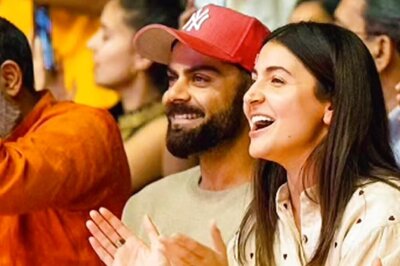
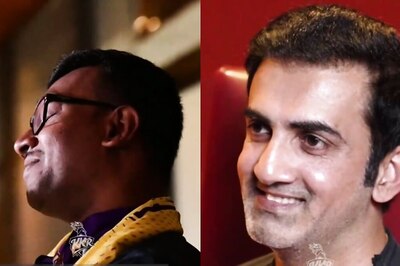
Comments
0 comment